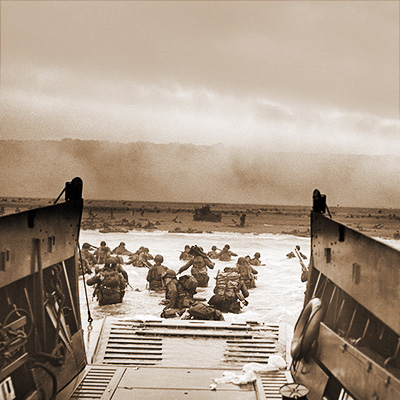Quiz Topic Sheet
World War II - The Battle of Normandy
The Battle of Normandy, also known as Operation Overlord, was one of the most decisive campaigns of World War II. It took place between June 6 and the end of August 1944, marking the beginning of the liberation of Nazi-occupied Europe.
Advertisement
Historical Background
- The Battle of Normandy was planned in response to the need to open a new front in Western Europe to relieve pressure on Soviet forces in the east.
- The Allies, led by the United States, the United Kingdom, Canada, and other nations, devised a plan for a massive invasion of German-occupied France.
Forces Involved
- Allied forces included approximately 156,000 American, British, Canadian, and other soldiers, supported by warships, combat aircraft, and paratroopers.
- German forces, under the command of Field Marshal Erwin Rommel, consisted of about 50 divisions totaling around 380,000 men, with reinforcements expected.
Preparations
- Operation Overlord required meticulous planning, including diversionary operations to deceive the Germans about the exact location of the landing.
- Airborne forces were dropped behind enemy lines to secure communication routes and strategic points.
Landing and Progression
- The landing took place on five beaches in Normandy, divided into sectors designated for American (Utah and Omaha), British (Gold and Sword), and Canadian (Juno) forces.
- Allied troops faced heavily fortified coastal defenses, including bunkers, obstacles, and machine guns.
- Despite heavy initial losses, the Allies succeeded in securing a foothold and advancing inland.
Decisive Battles
- The Battle of Caen, a strategic city, was particularly fierce, with intense street fighting and massive bombardments.
- The breakthrough at Avranches paved the way for the Allied advance southward, isolating German forces in Normandy.
Armaments and Tactics
- The Allies employed a range of modern armaments, including Sherman tanks, fighter aircraft, and warships to support infantry.
- The Germans used defensive fortifications, Tiger and Panther tanks, and counter-attack tactics to try to repel the invasion.
Generals
- On the Allied side, General Dwight D. Eisenhower was appointed Supreme Commander of the Allied Forces in Europe. He played a crucial role in the planning and execution of Operation Overlord.
- Among other prominent Allied generals were General Bernard Montgomery, commander of the Allied ground forces, and General Omar Bradley, commander of American ground forces.
- On the German side, Field Marshal Erwin Rommel, nicknamed the "Desert Fox" for his successes in North Africa, was responsible for coastal defense in Normandy. However, he was in Germany at the time of the invasion and could not immediately react to events on the ground.
Propaganda
- Before the invasion, the Allies conducted a massive disinformation campaign to mislead the Germans about the date and location of the landing. This included false information about supposed landings in other regions and the creation of fake military equipment to deceive enemy spies.
- Once the invasion was launched, the Allies also used propaganda to encourage French resistance to support the invasion and disrupt German troop communications and movements.
Secret Services
- Secret services on both sides played a crucial role in the preparation and conduct of the Battle of Normandy. The Allies benefited from intelligence provided by resistance networks in occupied France, as well as from the interception and decoding of German communications.
- The Germans also had their own intelligence services, although their effectiveness was compromised by Allied counter-espionage operations, such as the use of false information to deceive German intelligence services.
Consequences
- The Battle of Normandy marked a major turning point in the war in Europe, leading to the liberation of France and the subsequent collapse of the Nazi regime.
- Human losses were enormous, with thousands killed, wounded, and missing on both sides, but the Allied victory was decisive.
Advertisement
Quiz questions preview
-
Who was responsible for coordinating Allied ground operations in Normandy?
Miles Dempsey | Bernard Montgomery | Dwight D. Eisenhower | George Patton -
What underground movement against Nazi occupation played a key role in the Battle of Normandy?
Freedom League | Dawn Fighters | French Resistance | Free Force -
What does "D-Day" represent in the context of the Second World War?
The Normandy landings | The dropping of the atomic bomb on Hiroshima | The start of the German Blitzkrieg | The attack on Pearl Harbor -
How did so many Allied paratroopers die, apart from enemy fire?
Drowned after landing in flooded areas | Electrocuted by touching power lines | Wrecked by landing on anti-personnel mines | Poisoned by toxic gases -
By what name is June 6, 1944, the day of the Normandy landings, also known?
V-Opeation | X-Apocalypse | M-Moment | D-Day


